Meteora: Greece's spectacular monasteries in the sky
By Jarryd Salem, CNN
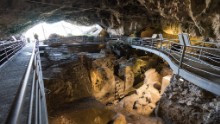
Photos:
Theopetra Cave: Theopetra Cave has evidence of continuous human inhabitation going back 130,000 years. A 23,000-year-old wall, thought to be one of the world's oldest man-made structures, stands at the mouth of the cave.
Hide Caption
7 of 11

Photos:
Working monasteries: The six other monasteries all have intricate religious murals in their halls and chapels. Despite the boom in tourism they are still fully functioning for the monks and nuns who live there.
Hide Caption
8 of 11

Photos:
Summit hiking: The outdoor activities available in this stunning landscape are helping boost visitor numbers every year. Hiking is very accessible, with many trails starting and ending right in town.
Hide Caption
9 of 11
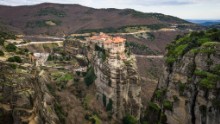
Photos:
Suspended in the air: The precarious locations of the monasteries helped protect the monks from battles and invaders for centuries.
Hide Caption
10 of 11
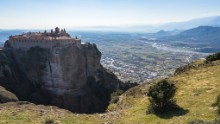
Photos:
Monasteries with a view: The monasteries offer incredible views over the Plain of Thessaly.
Hide Caption
11 of 11
Photos:
Meteora: This celebrated view of Meteora has become one of the most photographed spots in Greece.
Hide Caption
1 of 11
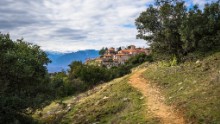
Photos:
The Great Meteoron Monastery: The region's largest and oldest monastery is the Great Meteoron. Meteora means "suspended in the air" and this place of worship gave its name to the entire region.
Hide Caption
2 of 11
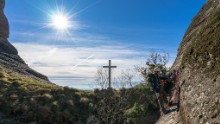
Photos:
Abseiling the Great Saint: The sandstone peaks have become a hot destination for rock climbers and hikers. A popular excursion is the Via Ferrata up Meteora's highest mountain, the Great Saint.
Hide Caption
3 of 11
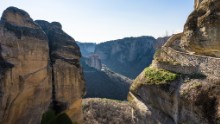
Photos:
Fancy a walk on this cliff?: Years ago the only access to the monasteries was by a rope and pulley system, or by free-climbing the cliffs. In the 1920s stairs were constructed, allowing safer travel for monks and visitors.
Hide Caption
4 of 11
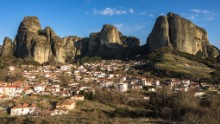
Photos:
Kastraki village: While the town of Kalambaka receives the majority of tourists, neighboring Kastraki village is quieter and equally picturesque.
Hide Caption
5 of 11
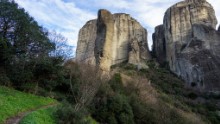
Photos:
Climb the Spindle: Meteora is a rock climber's paradise, and this striking monolith known as "The Spindle" is one of the most popular climbing challenges.
Hide Caption
6 of 11

Photos:
Theopetra Cave: Theopetra Cave has evidence of continuous human inhabitation going back 130,000 years. A 23,000-year-old wall, thought to be one of the world's oldest man-made structures, stands at the mouth of the cave.
Hide Caption
7 of 11

Photos:
Working monasteries: The six other monasteries all have intricate religious murals in their halls and chapels. Despite the boom in tourism they are still fully functioning for the monks and nuns who live there.
Hide Caption
8 of 11

Photos:
Summit hiking: The outdoor activities available in this stunning landscape are helping boost visitor numbers every year. Hiking is very accessible, with many trails starting and ending right in town.
Hide Caption
9 of 11

Photos:
Suspended in the air: The precarious locations of the monasteries helped protect the monks from battles and invaders for centuries.
Hide Caption
10 of 11

Photos:
Monasteries with a view: The monasteries offer incredible views over the Plain of Thessaly.
Hide Caption
11 of 11
Photos:
Meteora: This celebrated view of Meteora has become one of the most photographed spots in Greece.
Hide Caption
1 of 11

Photos:
The Great Meteoron Monastery: The region's largest and oldest monastery is the Great Meteoron. Meteora means "suspended in the air" and this place of worship gave its name to the entire region.
Hide Caption
2 of 11

Photos:
Abseiling the Great Saint: The sandstone peaks have become a hot destination for rock climbers and hikers. A popular excursion is the Via Ferrata up Meteora's highest mountain, the Great Saint.
Hide Caption
3 of 11

Photos:
Fancy a walk on this cliff?: Years ago the only access to the monasteries was by a rope and pulley system, or by free-climbing the cliffs. In the 1920s stairs were constructed, allowing safer travel for monks and visitors.
Hide Caption
4 of 11

Photos:
Kastraki village: While the town of Kalambaka receives the majority of tourists, neighboring Kastraki village is quieter and equally picturesque.
Hide Caption
5 of 11

Photos:
Climb the Spindle: Meteora is a rock climber's paradise, and this striking monolith known as "The Spindle" is one of the most popular climbing challenges.
Hide Caption
6 of 11
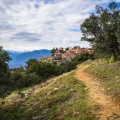

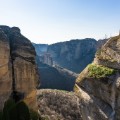
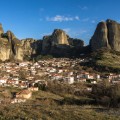
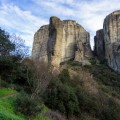
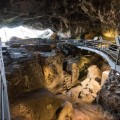

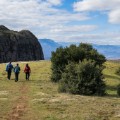
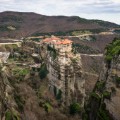
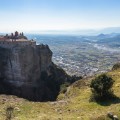
Story highlights
- The monasteries of Meteora are one of Greece's biggest attractions
- The area's also popular for adventure travel, including rock-climbing and rafting
(CNN)High above the Meteora landscape in Greece's central region, 60 monks and nuns live in fabled monasteries perched on the edge of sandstone peaks.
In centuries past, their place of worship brought them solitude and protection from unwanted trespassers.
Today, the Orthodox monasteries are one of the most popular destinations in all of Greece.
Only a few hours from Athens at the fringe of the Plain of Thessaly, the town of Kalambaka plays host to Meteora's spectacular mountaintop attractions.
Windswept monoliths rise abruptly from the earth, with vertical cliffs forming a dramatic backdrop against the flat fields around them.
The picture-perfect vistas have been the inspiration for countless film and TV backdrops, including the Eyrie kingdom in HBO series "Game of Thrones."
Historical playground

The monasteries' precarious location helped protect the monks from invaders.
But beyond the monasteries and mountains, Meteora is far from being just a visual delight.
This little-known terrain holds claim to some of Europe's most fascinating history, as well as a heap of exhilarating outdoor activities.
Just 2.5 miles outside of Kalambaka is Theopetra Cave, a stunning archaeological site that holds evidence of continuous human inhabitation for over 130,000 years.
The transition from Neanderthal to Homo sapiens is indicated in the layers of soil, and remarkably one of the world's oldest known man-made structures lies at the cave entrance: a wall believed to be 23,000 years old.
It's a phenomenal attraction that anywhere else in the world would be enough to warrant travel to the area, yet this cave is often overshadowed by the even more impressive and awe-inspiring buildings nearby.
Suspended in the air
During the 14th century, the great monk Athanasios Koinovitis brought a group of devout followers from Mount Athos to Meteora, in search of a group of ascetic hermits that had developed a religious stronghold in the region.
He was mesmerized by the hermits' free-climbing skills that had allowed them to live in the caves and fissures high above the ground, and saw an opportunity to create a convent where his flock could meditate and worship in peace.
Employing the hermits as climbing mentors, the new visitors conquered the surrounding mountains and set about creating their own holy haven.
It was then, from 1356 to 1372, that the first Great Meteoron Monastery was born.
Meteora means "suspended in the air," and the way the religious house clung dangerously to the formidable peak quickly gave its name to the entire district.
Years later when the Turks advanced on northern Greece, more monks escaped persecution by climbing the mountains to safety.
Over time 24 monasteries were built, with the steep pillars providing protection from the warriors below.
A network of ropes, pulleys, baskets and ladders were used to lift worshipers and supplies into the monasteries, and these were raised in times of danger to deny access to anyone who posed a threat.
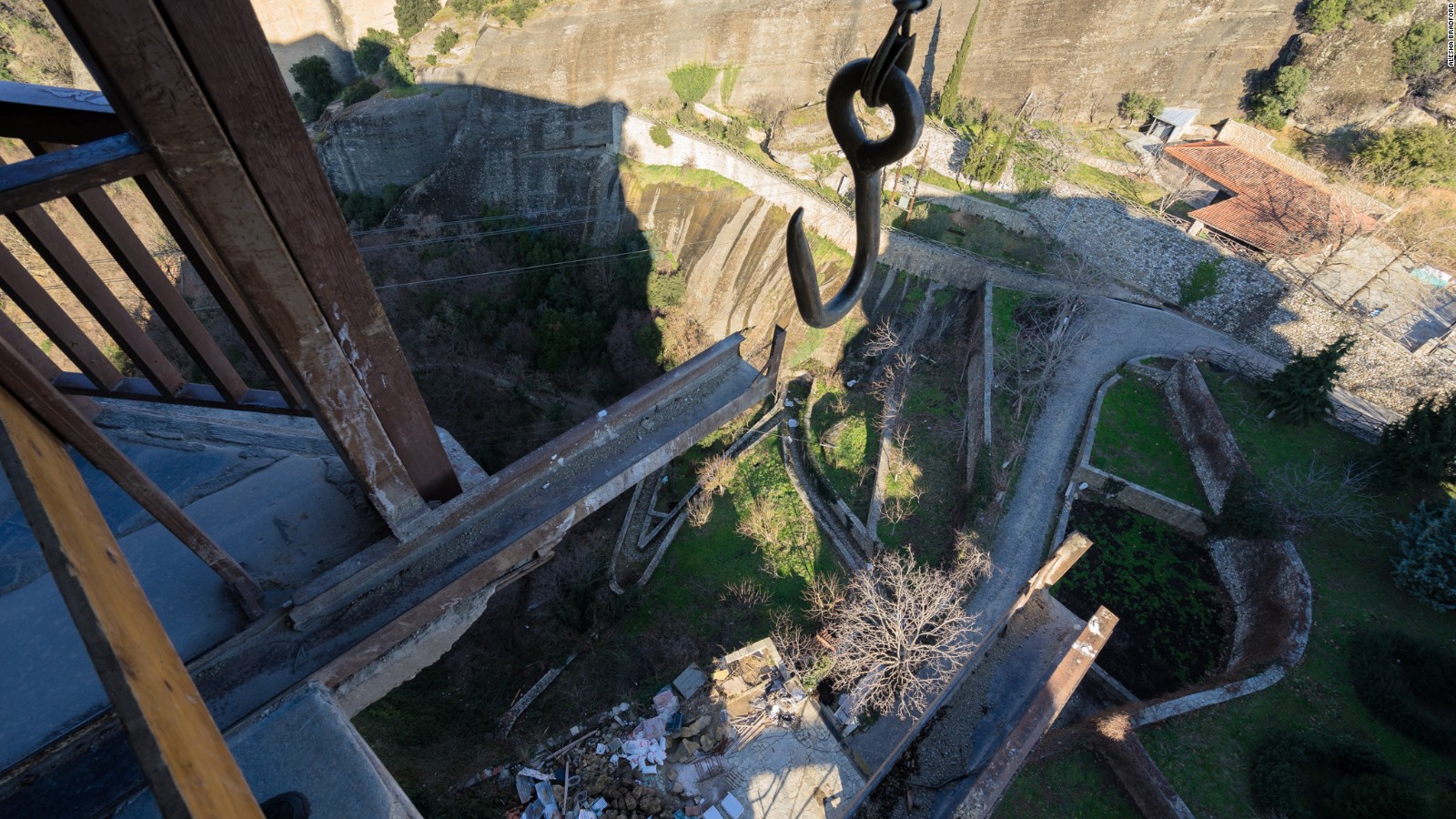
The monks used a network of ropes and pulleys to lift and lower supplies and people.
The method worked, and the Orthodox monks easily survived centuries of war and battles.
Today, six of these monasteries remain, segregated between male monks and female nuns, and visitors are welcomed with typical Greek hospitality.
Adventure tourism
Beyond the religious quarters, Meteora offers more than picturesque scenery and an education in ancient history. It's developed a reputation as Greece's adventure capital.
While most visitors opt for the popular driving and hiking excursions, always with a focus on visiting the monasteries, more active tourists look for alternative ways to reach for the heavens.
Those dramatic sandstone peaks have helped make Meteora a thriving hub for rock climbers from around the world.
The routes vary between bolted and traditional, and are suitable for absolute beginners through to professional climbers.
With many of the crags are accessible via a short hike from town, it's not uncommon to spot people hanging from the rocks just below the monasteries.
For those seeking something a bit different, a thrilling Via Ferrata, or "iron road" leads to the top of the Great Saint, the tallest mountain in Meteora.
A rocky trail leads towards the summit of the quarter-mile-high peak, with climbing ropes and chains used to assist in a safe climb and descent.
During the summer rafting has become another worthwhile adrenaline rush, and while it doesn't compare to the powerful rapids found elsewhere in Europe, it's still a heart-pumping pursuit.
Mountain biking rounds out the common activities, and for those that travel in winter, skiing and snowboarding can be found only a few hours from town.
Local destination company Visit Meteora provides guided tours and advice for the region, or experienced hikers and climbers can visit independently.
Year-round destination

The 40-meter-high "Spindle" monolith is one of the tougher climbing challenges.
Summertime brings immense hordes of tourists, with the trails, hotels and restaurants brimming with an energetic vibe.
Kalambaka can feel packed with visitors. However, neighboring Kastraki village offers a quieter, more intimate environment beneath the sandstone.
The higher temperatures and long days are the obvious attraction, but a mild climate actually means winter can be the best time to visit Meteora.
Without the summer crowds it's easy to find the monasteries virtually empty, and prices for accommodation drop.
This region of Greece has been attracting pilgrims and adventurers for thousands of years and, with the growth of adventure tourism, it's set to continue providing thrills both spiritual and visceral.
No comments:
Post a Comment